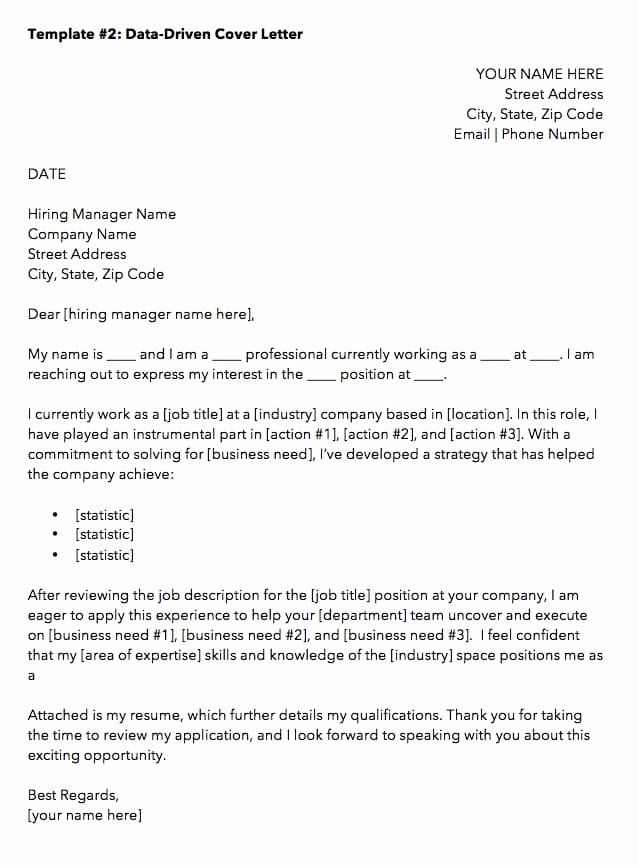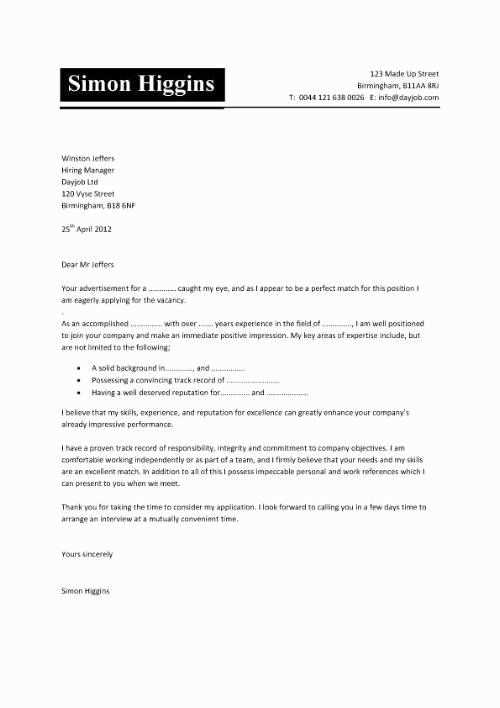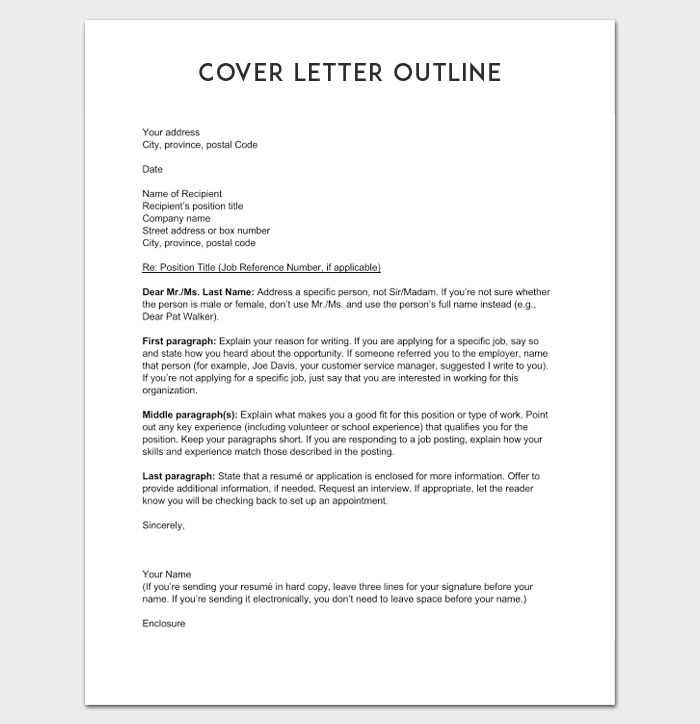Application cover letter template

Tailor your application cover letter to match the job description closely. Use clear, direct language to highlight why you’re the ideal fit for the position. Begin with a brief introduction that includes your name and the job title you’re applying for. Mention how you found the job posting and what excites you about the role.
Focus on your key qualifications. In the next paragraph, discuss your skills and experience that align with the company’s needs. Use specific examples that show how you’ve successfully handled tasks that are relevant to the role. Avoid generic phrases and focus on what sets you apart from other candidates.
Conclude your letter with a strong call to action. Let the employer know you’re eager to discuss your qualifications in more detail during an interview. Reaffirm your enthusiasm for the opportunity and express your availability for follow-up communication. End the letter with a polite, professional closing.
Application Cover Letter Template
Craft your cover letter with a clear structure, focusing on the skills and qualifications that directly relate to the job. Begin by addressing the hiring manager by name if possible, avoiding generic greetings.
Contact Information
Start with your contact information at the top of the page, including your full name, address, phone number, and email address. Then, list the company’s contact details right below your own, with the hiring manager’s name and title if available.
Opening Paragraph
In the first paragraph, mention the position you’re applying for and how you found out about it. Be specific about the company and express your enthusiasm for the role. Use this space to briefly explain why you are a strong fit for the position.
Example: “I am excited to apply for the Marketing Specialist role at XYZ Corporation. After learning about this opening through LinkedIn, I am confident that my 3 years of experience in digital marketing and my passion for data-driven strategies align perfectly with your company’s goals.”
Body Paragraphs
In one or two paragraphs, highlight your most relevant skills and achievements. Focus on your experience and how it will contribute to the company’s success. Back up your claims with examples, providing specific details about your work history that demonstrate your qualifications.
Example: “In my previous role at ABC Inc., I increased website traffic by 40% in six months by implementing an optimized content strategy. Additionally, my proficiency with analytics tools, such as Google Analytics and SEMrush, has allowed me to create targeted campaigns that directly improve ROI.”
Closing Paragraph
Conclude your cover letter by expressing interest in discussing the position further. Mention that you have attached your resume for review and indicate your availability for an interview. Thank the reader for their time and consideration.
Example: “I would welcome the opportunity to further discuss how my skills and experiences can contribute to the continued growth of XYZ Corporation. Please find my resume attached for your review. I look forward to hearing from you.”
Tip: Keep your tone confident, yet approachable, and avoid repeating your resume’s details word-for-word. A cover letter should complement your resume and provide insight into why you are the ideal candidate for the job.
Choosing the Right Structure for Your Cover Letter

The structure of your cover letter directly influences how your qualifications are perceived. Begin with a strong opening paragraph that clearly states the position you’re applying for and how you learned about it. Make it specific, and avoid vague references.
Follow up with a second paragraph detailing your relevant skills and achievements. Focus on how your experience aligns with the needs of the role. Use concrete examples to show your value, but keep it concise. Stay away from overly general statements that don’t highlight your unique strengths.
In the next section, address why you’re interested in the company. Show that you’ve researched its values, goals, or culture and explain how your background supports their mission. This adds a personal touch and demonstrates genuine interest.
Conclude your cover letter with a call to action. Reiterate your enthusiasm for the role and express a desire to discuss how you can contribute to the team. Keep this part positive and professional, leaving a lasting impression.
Keep the structure clear, with distinct paragraphs, and avoid cramming too much information into one section. A well-organized cover letter makes it easy for the reader to follow and highlights your qualifications effectively.
How to Address the Hiring Manager Correctly
Begin with “Dear” followed by the hiring manager’s full name, if you know it. Avoid using informal greetings like “Hey” or “Hi” in professional correspondence. If the hiring manager’s name is not available, use a general title such as “Dear Hiring Manager” or “Dear [Company Name] Recruiting Team.” Addressing the recipient by their title and last name creates a respectful tone.
Using “Mr.” or “Ms.”
When you know the hiring manager’s gender and name, use “Mr.” or “Ms.” followed by their last name. Avoid using “Miss” or “Mrs.” unless you’re certain of the preferred title. If you are unsure of their gender, “Dear [First Name] [Last Name]” is a safe, neutral approach.
Double Check the Details

Before sending the cover letter, verify that you have the correct name and spelling of the hiring manager. Small errors in the name can give a poor first impression. You can check the company’s website or LinkedIn to confirm their full name and correct title.
Maintaining a professional and polite approach while addressing the hiring manager helps set a positive tone for your cover letter.
Highlighting Your Skills Relevant to the Job
Focus on the skills directly related to the job description. Tailor your skills to match the qualifications outlined in the job posting. For each skill, provide a specific example that demonstrates your ability to succeed in the role. Quantify your achievements when possible to show your impact.
Use a table to clearly outline the key skills and how you apply them in your previous roles:
| Skill | Application in Previous Role | Impact |
|---|---|---|
| Project Management | Led a cross-functional team to deliver product updates ahead of schedule | Increased team efficiency by 30% and exceeded customer expectations |
| Data Analysis | Analyzed customer data to improve marketing strategies | Improved campaign ROI by 15% |
| Communication | Presented quarterly reports to senior management | Facilitated clear decision-making and improved interdepartmental collaboration |
By organizing your skills in this way, you make it easier for the hiring manager to see how your abilities align with their needs. Always provide concrete examples that prove your competence, rather than simply listing qualifications.
Writing a Strong Opening Paragraph

Begin with a concise statement that grabs attention. Clearly express the role you’re applying for and why you’re the right fit. This opening should immediately highlight your enthusiasm and qualifications without being overly wordy.
- State the position you’re applying for clearly.
- Mention where you found the job listing, adding context if relevant.
- Briefly mention how your skills or experience align with the role.
For example, instead of saying “I am interested in the position,” specify what excites you about the opportunity and how your background directly ties into the company’s needs. Avoid generic statements and clichés. Personalize each opening paragraph to reflect your unique qualifications.
Keep it focused. The goal is to capture the reader’s attention and make them want to continue reading your letter. A direct, confident tone will set the right tone for the rest of your application.
Demonstrating Your Fit with the Company Culture
Align your values with those of the company. Research their mission, vision, and core principles. Reflect these elements in your cover letter by showing how your experiences and values mirror theirs. For instance, if the company prioritizes innovation, mention how you contributed to innovative projects in your past roles.
Highlight your adaptability to their work environment. If the company values teamwork, share specific examples where you successfully collaborated with diverse teams. If they emphasize independent problem-solving, describe a scenario where you tackled challenges on your own while achieving company goals.
Showcase your understanding of their industry and work style. If they value speed and efficiency, explain how you’ve thrived in high-pressure situations, meeting deadlines without compromising quality. If their work culture is more relaxed and creative, highlight how you thrive in such environments, ensuring productivity while maintaining flexibility.
Conclude by demonstrating your enthusiasm for their company culture. Mention how their values resonate with your own professional goals, and how you’re excited about contributing to their team. This will illustrate not just your qualifications, but also your genuine interest in being part of their work environment.
Concluding with a Clear Call to Action
End your cover letter with a direct call to action. Make it easy for the reader to know what step to take next. For example, invite them to contact you to schedule an interview. A sentence like, “I look forward to discussing how my skills can benefit your team” is clear and professional. Avoid leaving them guessing about how to proceed. Encourage action by expressing enthusiasm and openness, but keep it concise.
Be confident but respectful in your wording. Suggest a timeline for follow-up or indicate your availability. For instance, “I am available for an interview at your earliest convenience and can be reached via email or phone” lets the reader know you’re proactive and easy to reach.
Always finish with a polite closing statement. A simple “Thank you for your time and consideration” conveys gratitude while reinforcing professionalism.